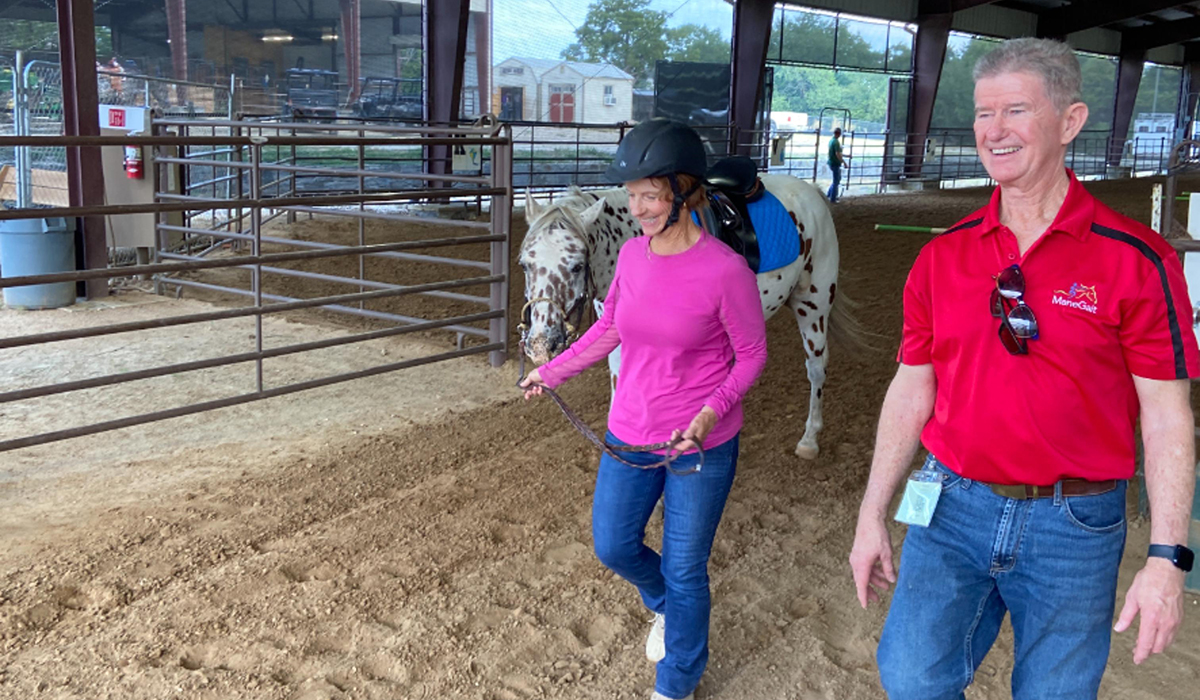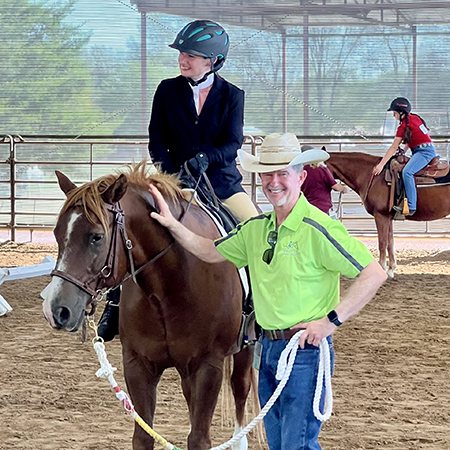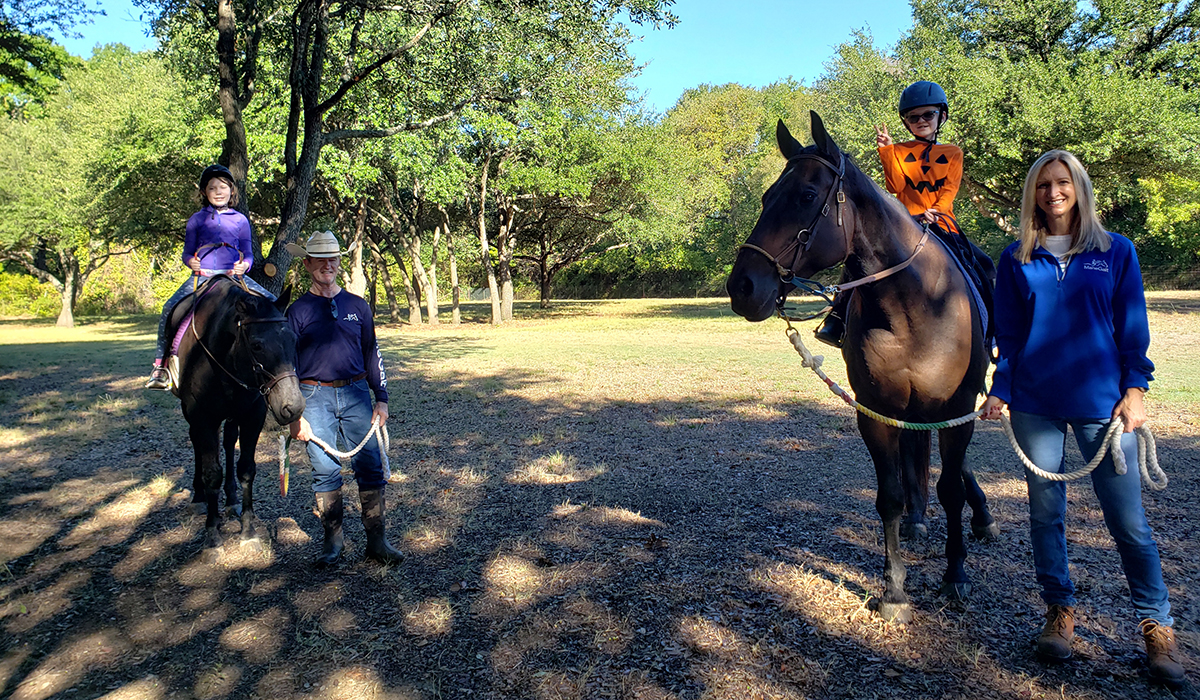From Service to Sidewalker: A Volunteer’s Healing Ride

Meet Daily Point of Light Award honoree Jim Dougherty. Read his story, and nominate an outstanding volunteer or family as a Daily Point of Light.
After serving his country as a military veteran, Jim Dougherty began a new chapter in his life – one that would lead him to ManeGait, a therapeutic riding program for veterans and people with disabilities. He originally joined as a volunteer, a way to occupy his retirement years. But it wasn’t long before he also became a participant in the veteran’s program. There, he found a renewed sense of purpose and healing through the calming rhythm of a horse’s gait, a feeling he now helps others discover every time he’s at the ranch.
Over the last eight years, Jim has become an indispensable member of the ManeGait community, dedicating over 1,100 hours to the organization. He’s often the first one to arrive and the last to leave, showing up three to four times a week to serve as a horse leader and sidewalker. His calm and reassuring presence brings comfort to the children and adults he works with, helping them feel safe and supported as they grow in confidence and ability. He is also known for brightening everyone’s day, whether with a kind word or a box of sweet treats and coffee for the staff and his fellow volunteers.
Beyond his direct work with riders, Jim has also leveraged his expertise to strengthen the organization itself. With his background in IT, he has played a key role on the Volunteer Committee, helping to improve the systems and processes that manage ManeGait’s extensive network of volunteers. This behind-the-scenes work ensures that the program runs smoothly, allowing the organization to continue its vital mission.
Jim’s dedication to ManeGait is also personal. He shares that volunteering with children with disabilities has unexpectedly strengthened the bond he shares with his own granddaughter, who was born with a disability. Volunteer work has become so much more than a way to fill his time; it has become a way to connect with the world on a deeper, more meaningful level. Read on to hear more of his deeply moving and inspirational story.

Tell us about your volunteer role.
I’m primarily a leader and a side walker. I also assist with fundraisers and events. ManeGait is a therapeutic horseback riding center for special needs children and adults. It serves the North Dallas area. We also have a GaitWay to the Brain program, which I actually participated in for about 18 months, with some of the other disabled veterans. This program incorporates brain-building exercises into the framework of equine therapy to increase outcomes for riders.
There are hundreds of riders, with several hundred more currently on a waiting list. We’re in the middle of a $12 million expansion of the facility, which looks like it might be completed this year. MainGait also helps other equine centers around the country. Part of our expansion is a big conference facility, so that they can do more work with centers that are just starting up.
What inspired you to get started with this initiative?
I live only a mile away from MainGait, so I used to see it regularly driving down the main road in and out of my community. But where I really found out about it was from my employer’s site. I worked for Raytheon company, and they really encourage volunteering. I looked on the MainGait website and signed up for a training session. I started off as a barn buddy, which is mucking stalls, moving horses to the pasture, feeding them. I’m older, so the barn buddy work was pretty heavy for me. Next, I got into sidewalking. I help train new sidewalkers and horse leaders too. It’s amazing work.
Tell us more about why equine therapy works.
From a physical standpoint, one important note is that a horse’s gait is extremely similar to a human’s gait. So for riders who can’t walk, or can’t walk well, just being on the horse can help move their hips in such a way to stimulate the nerves and the muscles that help them walk. And there’s the steering the horse, starting and stopping the horse; these riders are going through patterns, negotiating weaving patterns between cones.
There’s also a lot of camaraderie between the riders. While we’re getting the horses lined up, the riders have a little bit of time to communicate with one another, so they’re building friendships, which can be difficult for special needs children and adults. We have a horse show every year, and some of them go on to compete in bigger horse shows in the greater DFW area. For those involved in the GaitWay to the Brain program, that’s a different kind of therapy. Having gone through it myself, it helped me with attention span and focus, and mood stabilization. Five years after my time in that program, I still do the exercises at home.
What’s been the most rewarding part of your work?
I have an 11-year-old special needs granddaughter. Part of this was to know how I could help provide therapy. I can tell you, it’s had an extraordinary impact on my relationship with her. Earlier this year, she started having problems with balance. She was terrified of stairs, escalators, elevators. It got so bad that she would crawl out of the car onto the sidewalk because of the step. The last time we were out to visit her, we went to the playground and I was told she probably wouldn’t do any of the swings or the slides. Initially she didn’t want to go up to the playground equipment. At first, she was very reluctant. But I got on the swings, and invited her to join me. And she did. She hadn’t done this for months. Next, I said, “Why don’t we go up the slide?” She was scared of the steps, and she didn’t want to do it. I was patient, and then encouraged her. And she climbed up the metal steps. Soon, she was not only doing these things, but doing them on her own.
I’ve learned both how to encourage, and how to have patience. Both are important. Equine therapy requires continual encouragement and patience. But when you get positive responses from the riders, it’s so worth it. Sometimes it’s hand over hand, to help them with the steering, or helping them up out of the saddle. But then you work with them, and then they can do it. Or sometimes they don’t want to do it, and you encourage them and they do it. So seeing that and knowing what I’ve learned at ManeGait has helped my granddaughter and my relationship with her.

What have you learned through your experiences volunteering?
One thing I’ve learned is a little bit more about disabilities, and how to be able to relate to people with disabilities – not just at ManeGait but at an airport or grocery store. Sometimes it’s just a little, “Hi, how are you doing today?” to brighten their day. Even with my 5-year-old grandson, it’s helped me interact with him. He’s not special needs, but the same patience, encouragement and understanding are needed when he gets upset.
Why is it important for others to get involved with causes they care about?
The thing is that you can actually have a big impact on somebody else’s life. A lot of people out there don’t know that they can go out and do that, help other people who need help. I’ve realized that I have all these talents I didn’t notice before, and I learned that through volunteering.
Any advice for people who want to start volunteering?
What I notice in the ManeGait community is that these individuals are extraordinarily encouraging, not just to their clients, but also to the volunteers and the staff members. The camaraderie between staff and between the volunteers is almost like a close-knit family. We’re all volunteering, so we already have a lot in common.
Do you want to make a difference in your community like Jim? Find local volunteer opportunities.
